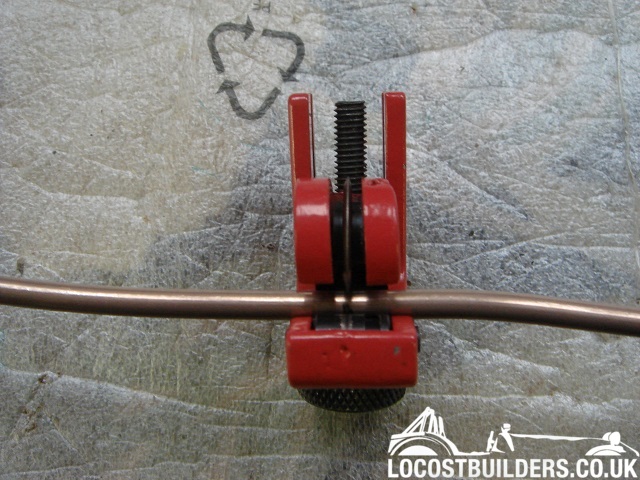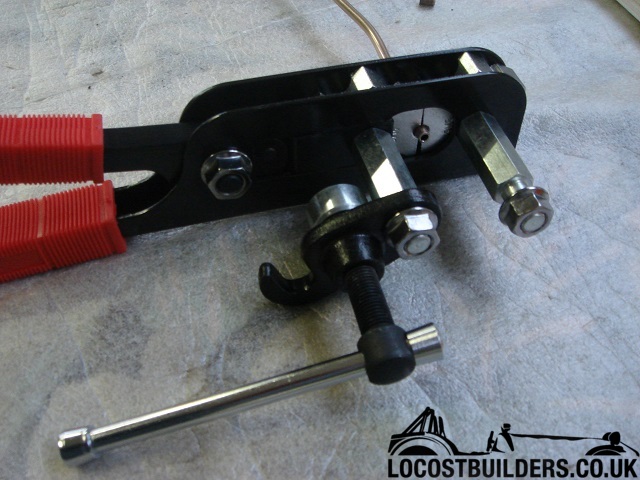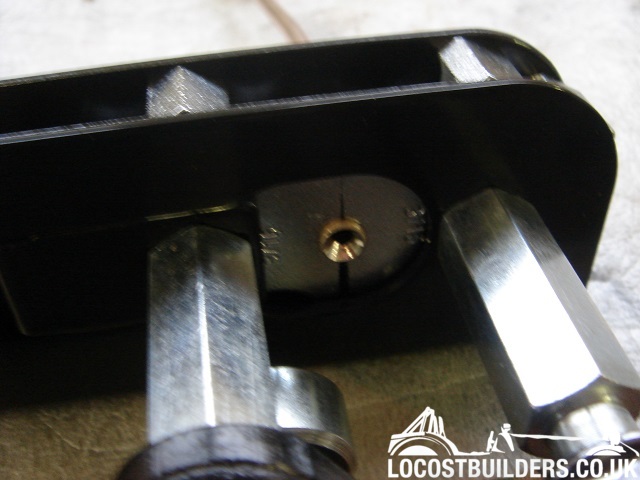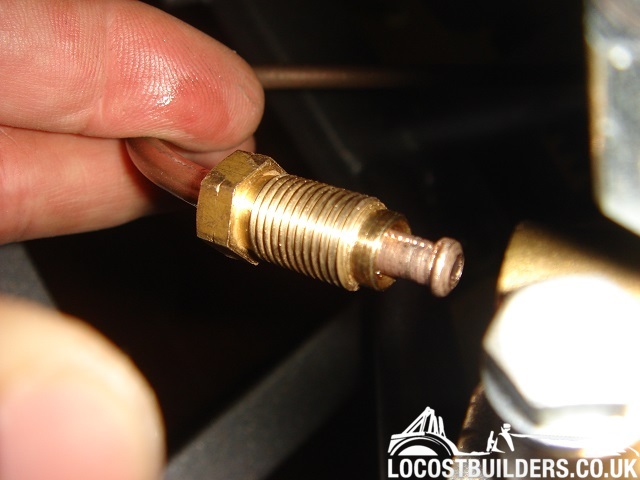MadMaxx
|
| posted on 30/5/22 at 10:36 PM |

|
|
Leaking new braking lines
Hi, today I filled the new brake line with fluid and found all the connection points leaking.
What could be the reason, considering that it leaks from any connection?
Overtightening? mishaping of the flaring? What else?
My re-building diary:
http://www.llcc.it/YetAnotherForum.NET/default.aspx?g=posts&t=13448
|
|
|
|
|
adithorp
|
| posted on 31/5/22 at 06:30 AM |

|
|
Posibly bad flares (or wrong flares) but doubt you'd have that on every end (unless you really fecked up when making them).
Undertighteningis more likely. On first fitting, remember there'll be a fair amount of compression of the new flare after the initial contact and
before it's tight.
Never seen a leak caused by overtightening.
"A witty saying proves nothing" Voltaire
http://jpsc.org.uk/forum/
|
|
|
MadMaxx
|
| posted on 31/5/22 at 06:51 AM |

|
|
I will post some photos later
My re-building diary:
http://www.llcc.it/YetAnotherForum.NET/default.aspx?g=posts&t=13448
|
|
|
Mr Whippy
|
| posted on 31/5/22 at 07:07 AM |

|
|
Have you even remembered to tighten them up? sounds stupid but I've done that before. It's amazing how many times I've forgot to
tighten bolts up, especially when in a rush or working at night. A paint pen is a really good practice for marking off anything fully tightened.
Might be that you've done the wrong type of flare, some need a double to make up the clearance. Another possibility is mixing up metric with
imperial. There's one type of fitting that actually screws together but doesn't grip right. If they are all leaking then there's
something fundamentally wrong with your method you need to investigate.
|
|
|
Slimy38
|
| posted on 31/5/22 at 07:45 AM |

|
|
It'll be interesting to know what you find. For me I have a concern around the initial tightening. As Adithorp mentioned I am expecting the first
tightening to need a little more 'oomph' to get things to sit right. But I'm using Kunifer rather than copper, which I've already
realised is a fair bit stronger to form and bend. So I'm expecting to have to tighten things even tighter than normal.
What does sound unusual for you is that it's 'every' join. On the assumption that you have a variety of joins (pipe to flexi, pipe to
t-joint, pipe to brake cylinder etc), it does suggest a process issue. Is it definitely every join or are there at least some that aren't
leaking?
Have you flared brake pipes before, are you comfortable with how they were done?
|
|
|
MadMaxx
|
| posted on 31/5/22 at 08:04 AM |

|
|
https://www.locostbuilders.co.uk/photos.php?action=showphoto&photo=DSC08303.JPG
Process used to flare:
[img] [/img] [/img]
[img] [/img] [/img]
[img] [/img] [/img]
[img] [/img] [/img]
My re-building diary:
http://www.llcc.it/YetAnotherForum.NET/default.aspx?g=posts&t=13448
|
|
|
MadMaxx
|
| posted on 31/5/22 at 08:16 AM |

|
|
quote:
Originally posted by Slimy38
It'll be interesting to know what you find. For me I have a concern around the initial tightening. As Adithorp mentioned I am expecting the first
tightening to need a little more 'oomph' to get things to sit right. But I'm using Kunifer rather than copper, which I've already
realised is a fair bit stronger to form and bend. So I'm expecting to have to tighten things even tighter than normal.
What does sound unusual for you is that it's 'every' join. On the assumption that you have a variety of joins (pipe to flexi, pipe to
t-joint, pipe to brake cylinder etc), it does suggest a process issue. Is it definitely every join or are there at least some that aren't
leaking?
Have you flared brake pipes before, are you comfortable with how they were done?
I also used Kunifer and first tightened strong, that tried very strong, but apparently no difference. Do I have to check if pipe is bedding properly
in position? Could be a problem of some denting due to deformation done during flaring?
I'm really frustrated.
My re-building diary:
http://www.llcc.it/YetAnotherForum.NET/default.aspx?g=posts&t=13448
|
|
|
daviep
|
| posted on 31/5/22 at 08:26 AM |

|
|
Your flare looks properly formed but it does look quite small, looks as if the nut might contact the bottom of the port without compressing the flare.
Possibly a trick of the camera.
Other thoughts:-
Are your flare nuts long enough, ie there still some thread showing when the nut is tight?
Are you using the correct flare to match the port ie convex or concave?
Cheers
Davie
“A truly great library contains something in it to offend everyone.”
|
|
|
adithorp
|
| posted on 31/5/22 at 09:14 AM |

|
|
Couple of things from those pic's (looking on my phone and a bit blurry zoomed in)...
The flare in pic 3 looks a bit small and in pic one the pipe might need to be further out before flaring to correct. Pic 2 looks like a double/concave
flare and three a single/convex ? Pic 3 also seems to have some damage to the pipe behind the flare.
"A witty saying proves nothing" Voltaire
http://jpsc.org.uk/forum/
|
|
|
MadMaxx
|
| posted on 31/5/22 at 09:14 AM |

|
|
quote:
Originally posted by daviep
Your flare looks properly formed but it does look quite small, looks as if the nut might contact the bottom of the port without compressing the flare.
Possibly a trick of the camera.
Other thoughts:-
Are your flare nuts long enough, ie there still some thread showing when the nut is tight?
Are you using the correct flare to match the port ie convex or concave?
Cheers
Davie
Good tips e following my observations:
- I will check if the flare is really compressed (that's my major concern)
- The leaking is between the pipe and the nut compressing it
- Yes, some thread is still in sight after having tightened the nut
- Could the dents left by flaring tool influence the bedding of the flared end of pipe between the nut and the case?
My re-building diary:
http://www.llcc.it/YetAnotherForum.NET/default.aspx?g=posts&t=13448
|
|
|
daviep
|
| posted on 31/5/22 at 09:31 AM |

|
|
quote:
Originally posted by MadMaxx
Good tips e following my observations:
- I will check if the flare is really compressed (that's my major concern)
- The leaking is between the pipe and the nut compressing it
- Yes, some thread is still in sight after having tightened the nut
- Could the dents left by flaring tool influence the bedding of the flared end of pipe between the nut and the case?
Where are the dents? if they are from the clamping bar then I would not expect them to cause sealing problems.
If you remove a union that you have tightened you may be able to see a witness mark either on the bottom of the nut or in the port, if the the nut has
contacted the bottom of the port.
You can also make a test piece and assemble it on the bench to allow you to test whether the pipe is properly clamped.
Davie
“A truly great library contains something in it to offend everyone.”
|
|
|
40inches
|
| posted on 31/5/22 at 09:33 AM |

|
|
The counter-sinking on the nuts looks a bit excessive?
Just checks all my spares and they don't have any counter-sinking!
I have these CBS nuts
|
|
|
MadMaxx
|
| posted on 31/5/22 at 09:55 AM |

|
|
quote:
Originally posted by adithorp
Couple of things from those pic's (looking on my phone and a bit blurry zoomed in)...
The flare in pic 3 looks a bit small and in pic one the pipe might need to be further out before flaring to correct. Pic 2 looks like a double/concave
flare and three a single/convex ? Pic 3 also seems to have some damage to the pipe behind the flare.
[img] [/img] [/img]
This is the photo of the nut I disconnect. Maybe some dents due to clamping of the flaring tool and a little flat end instead to be domed, so no
chance to be pushed against the case by the nut? Should I have to check and smooth the contact surface, if needed?
My concern is that "all" joints seem suffer of the same problem so it should be some error in some point of the process of flaring or
tightening, so my request of tips about to fix the problem.
My re-building diary:
http://www.llcc.it/YetAnotherForum.NET/default.aspx?g=posts&t=13448
|
|
|
MadMaxx
|
| posted on 31/5/22 at 10:02 AM |

|
|
quote:
Originally posted by daviep
quote:
Originally posted by MadMaxx
Good tips e following my observations:
- I will check if the flare is really compressed (that's my major concern)
- The leaking is between the pipe and the nut compressing it
- Yes, some thread is still in sight after having tightened the nut
- Could the dents left by flaring tool influence the bedding of the flared end of pipe between the nut and the case?
Where are the dents? if they are from the clamping bar then I would not expect them to cause sealing problems.
If you remove a union that you have tightened you may be able to see a witness mark either on the bottom of the nut or in the port, if the the nut has
contacted the bottom of the port.
You can also make a test piece and assemble it on the bench to allow you to test whether the pipe is properly clamped.
Davie
Later in the afternoon I will make some photos of all details and post them
My re-building diary:
http://www.llcc.it/YetAnotherForum.NET/default.aspx?g=posts&t=13448
|
|
|
adithorp
|
| posted on 31/5/22 at 11:46 AM |

|
|
If the flare isn't sealing then the leak will be between nut and pipe. It won't appear up the threads as they're tight so it'll go
route of least resistance up the pipe.
As said above that countersink in the nut looks wrong for a metric nut. More like an old UNF.
Also if the flare in your picture is after fitting, then it's definitely not been compressed fully as I'd expect (is there an odd ridge in
the back of the flare as well?).
[Edited on 31/5/22 by adithorp]
"A witty saying proves nothing" Voltaire
http://jpsc.org.uk/forum/
|
|
|
obfripper
|
| posted on 31/5/22 at 12:33 PM |

|
|
The countersunk male tube nuts are for sae type single and double flares, the flat ended male tube nuts are for din flares, and female tube nuts are
for sae double flares.
Most european cars use din flares, ford do use din male to sae female on ka/fiesta/focus rear brake pipes (to save the cost of a female-female
connector), but should otherwise be seen as incompatible with sae fittings, things are even less clear where metric threads are being used with sae
flares which is quite common on japanese and us market vehicles.
Most din applications use nuts with an unthreaded section at the flare end, if you use fully threaded nuts in place of these, the thread will bottom
out before a seal is made as they are not fully threaded at the female end.
I did have a good chart with all the options, but cannot find it at the moment, it also had sectional views to help identify the correct fitting where
the original was not available
Dave
|
|
|
Mr Whippy
|
| posted on 31/5/22 at 03:46 PM |

|
|
dito the countersink issue, first I've seen those tbh. I only use the type without that, you may have found the problem. Sadly its new pipe time

I think your over tightening the clamp as you've left some quite deep marks in the pipe.
[Edited on 31/5/22 by Mr Whippy]
|
|
|
MadMaxx
|
| posted on 31/5/22 at 04:22 PM |

|
|
quote:
Originally posted by adithorp
If the flare isn't sealing then the leak will be between nut and pipe. It won't appear up the threads as they're tight so it'll go
route of least resistance up the pipe.
As said above that countersink in the nut looks wrong for a metric nut. More like an old UNF.
Also if the flare in your picture is after fitting, then it's definitely not been compressed fully as I'd expect (is there an odd ridge in
the back of the flare as well?).
[Edited on 31/5/22 by adithorp]
So you think I mixed up different standard for joints (M10), nuts (M10) and flaring matrix (UNF?). I bought all on CBS site and did't know that
there could be the chance to do this confusion, because I thought the flaring was a standard despite using M10 or 3/8" . In your opinion, if I
retain the flaring tool and start with new pipe with UNF 3/8" nuts and joint, should I fix the leaks? Or I also have to check for a specific
flaring tool?
My re-building diary:
http://www.llcc.it/YetAnotherForum.NET/default.aspx?g=posts&t=13448
|
|
|
MadMaxx
|
| posted on 31/5/22 at 04:28 PM |

|
|
quote:
Originally posted by Mr Whippy
dito the countersink issue, first I've seen those tbh. I only use the type without that, you may have found the problem. Sadly its new pipe time

I think your over tightening the clamp as you've left some quite deep marks in the pipe.
[Edited on 31/5/22 by Mr Whippy]
I have to take out the body to have access to the rear T shape joint and need to cut, flare and fit again the pipe (that I have to buy with all the
UNF bits), but if this is the problem I'm happy to found it at least. I hoped to finally go for body shell paint next week, but I will wait a
little bit more.
My re-building diary:
http://www.llcc.it/YetAnotherForum.NET/default.aspx?g=posts&t=13448
|
|
|
MadMaxx
|
| posted on 31/5/22 at 04:29 PM |

|
|
Now I only hope to buy the right set of components to put together for new brake line...
My re-building diary:
http://www.llcc.it/YetAnotherForum.NET/default.aspx?g=posts&t=13448
|
|
|
nickm
|
| posted on 31/5/22 at 06:56 PM |

|
|
Hi
Just working from your pictures when you do a female flare do you not do a male one first ? your pictures show stage 1 normal pipe stage 2 female
flare
Been a few years since i did it though.
Nick M
|
|
|
MikeR
|
| posted on 31/5/22 at 07:16 PM |

|
|
I had that tool. I bought a different one as I found it offset the flare on the pipe to one side.
If you hold the pipe vertical, then roll it through your fingers 360 degrees I could see the flare stock out further one side than three other.
If I could be so bold to hijack, how do you know what flare to do? My new tool is the one recommended on here years ago. It only seems to do one type
of flare. What is the concave Vs convex and how do you know when to do which one?
link to the current tool. https://www.carbuilder.com/uk/hand-held-brake-pipe-flaring-tool
|
|
|
MadMaxx
|
| posted on 31/5/22 at 07:42 PM |

|
|
quote:
Originally posted by nickm
Hi
Just working from your pictures when you do a female flare do you not do a male one first ? your pictures show stage 1 normal pipe stage 2 female
flare
Been a few years since i did it though.
Nick M
It is not a sequence. I just wanted to show which tool I used and an example for both male and female ends.
My re-building diary:
http://www.llcc.it/YetAnotherForum.NET/default.aspx?g=posts&t=13448
|
|
|
MadMaxx
|
| posted on 31/5/22 at 07:50 PM |

|
|
quote:
Originally posted by MikeR
I had that tool. I bought a different one as I found it offset the flare on the pipe to one side.
If you hold the pipe vertical, then roll it through your fingers 360 degrees I could see the flare stock out further one side than three other.
If I could be so bold to hijack, how do you know what flare to do? My new tool is the one recommended on here years ago. It only seems to do one type
of flare. What is the concave Vs convex and how do you know when to do which one?
link to the current tool. https://www.carbuilder.com/uk/hand-held-brake-pipe-flaring-tool
I'm very upset for the waist of time due to my mistake in choosing M10 joints and nuts I wanted to finish the Fury during this weekend (4
days available due to Italian holiday) to go for body paint, that I accept any tip and extra money to be sure to correctly finish the brake line. I wanted to finish the Fury during this weekend (4
days available due to Italian holiday) to go for body paint, that I accept any tip and extra money to be sure to correctly finish the brake line.
If this tool will guaranty better and symmetrical finish I will buy it.
My re-building diary:
http://www.llcc.it/YetAnotherForum.NET/default.aspx?g=posts&t=13448
|
|
|
MadMaxx
|
| posted on 31/5/22 at 08:14 PM |

|
|
quote:
Originally posted by MikeR
I had that tool. I bought a different one as I found it offset the flare on the pipe to one side.
If you hold the pipe vertical, then roll it through your fingers 360 degrees I could see the flare stock out further one side than three other.
If I could be so bold to hijack, how do you know what flare to do? My new tool is the one recommended on here years ago. It only seems to do one type
of flare. What is the concave Vs convex and how do you know when to do which one?
link to the current tool. https://www.carbuilder.com/uk/hand-held-brake-pipe-flaring-tool
To buy the tool I have to choose one of the following:
- 3/16" pipe SAE flare
- 1/4" pipe SAE flare
- 3/16" pipe DIN flare
I also have to match the original flexible pipe already installed to connect the rigid line to each wheel.
Number 1 or 3?
My re-building diary:
http://www.llcc.it/YetAnotherForum.NET/default.aspx?g=posts&t=13448
|
|
|













